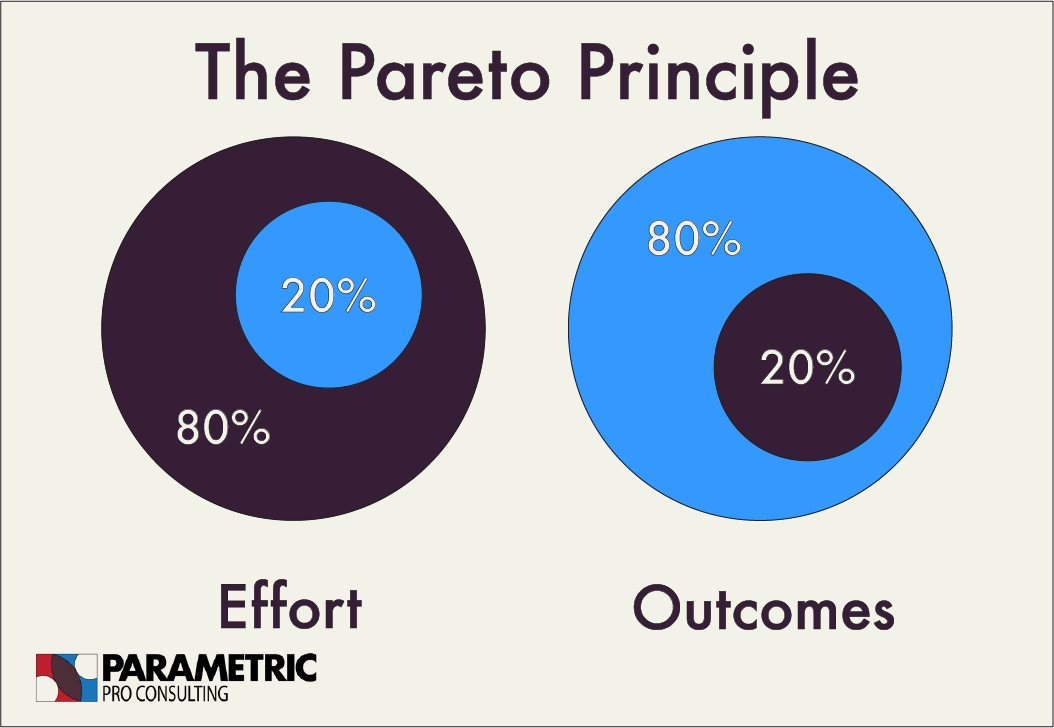The Pareto Principle
What is the Pareto Principle?
The Pareto Principle is an economic ideology that was developed by Joseph Juran, after reading the works of Italian Economist Vilfredo Pareto. This principle specifies that roughly 80% of consequences come from 20% of causes. It explores the idea of the relationship between inputs and outputs being unbalanced. You may have heard of the Pareto Principle being referred to as the Law of Vital Few, the Principle of Factor Sparsity, or more commonly the 80/20 rule.
When learning about this concept, it’s important to consider that the Pareto Principle is not a law, but an observation, meaning it won’t apply to every scenario. It’s not a formal mathematical equation, but a theory that can be observed in economics, business, time management and sports.
The Pareto Principle does not mean that only 20 percent of the things a company does is important, but it does mean that 20 percent of the things a company does are more important. Meaning the 20 percent should be prioritized.
Pareto’s inspiration for this principle stemmed from the connection between wealth and population. It was initiated in Italy when Pareto observed that 80% of the land was owned by 20% of the population. This didn’t solely apply in Italy though, soon after this observation, after surveying several other countries, Pareto discovered that this theory applied worldwide.
This economic theory is also very relevant in the workforce, for instance, oftentimes the efforts of 20% of a corporation’s employees drive 80% of the firm's profits. Another example can be recognized through donations or fundraisers, where 20% of the donors contribute 80% of the total amount of money raised.

How does this principle relate to business?
This principle is relevant to almost any business because 80 percent of a given business's profit typically comes from 20 percent of its clientele. Business owners who are mindful of this concept tend to focus their marketing efforts on that top 20 percent because that is the best way to maximize results. (We can see this principle in marketing as well, around 20 percent of marketing methods generate 80 percent of a company’s overall results.) It wouldn’t make sense to give each customer the same level of energy and time if they aren't all bringing in the same results.
Taking it one step further
Interestingly enough, Perry Marshall took this to the next level and discovered that the Pareto Principle exists within itself. As we know, generally in business 20% of your customers represent 80% of your total revenues. Marshall that the top 20% within the 20%, represents 64% of sales, which is calculated by multiplying 80% by 80%. To restate this, the top 4% of your customers represent 64% of sales. It just so happens that this concept continues, as the Pareto Principle scales to the third, fourth, five powers, and so on.
This principle is extremely effective when it comes to determining which areas you should be focusing your energy and resources on, to reach your business’s highest potential. Business owners can use this concept to manage and prioritize their tasks and time and restructure their work week, to understand where to best allocate efforts to maximize results. maximize results and profits.
Real-life examples
The Pareto Principle does not only apply in business, and is very applicable to our daily life. Let's look at a few quick examples.
20% of employees produce 80% of a company’s results.
20% of a given employee's time yields 80% of their output.
20% of software bugs cause 80% of software failures.
20% of a company’s investments produce 80% of its investment profits.
20% of factories create 80% of pollution.
20% of criminals commit 80% of crimes.
20% of clothes are worn 80% of the time.
Conclusion
It's important to put energy and effort into every component of your business, however, the amount of energy and time should be allocated differently from one thing to another. What you give should depend on what you receive in return. Understanding that 20% of customers are generating 80% of total sales is an essential business tool. From here you can prioritize your energy to this group of people, and use the time you have left to care for the other 80%.
It’s extremely important that people understand that just because you should prioritize that 20 percent, doesn't mean you should neglect the other 80. Neglect could very easily lead to the downfall of a company.
This concept can help you redirect your resources for maximum efficiency and output, and it can have a massive impact on the growth and profitability of your company.
If this article was helpful to you, please consider sharing it with your network!
For more useful information, check out our other Insights!
Are you interested in the consulting industry? Parametric Pro Consulting Foundations offers more in-depth knowledge on this article as well as several other topics to prepare you for a career in business and consulting. Check it out here!
